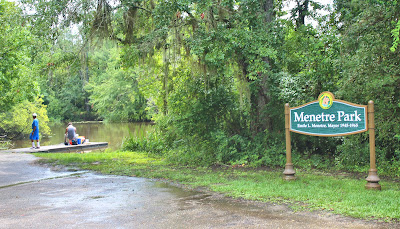In 1909, Alcée Fortier, Lit. D., a professor of Romance Languages in Tulane University, edited a two volume encyclopedia on the state of Louisiana. It was described as "Comprising Sketches of Counties, Towns, Events, Institutions and Persons, Arranged in Cyclopedic Form." It was published in Atlanta, GA, by the Southern Historical Association.
Here are some excerpts from the encyclopedia entry regarding St. Tammany Parish.
"St. Tammany Parish, established in 1811, is one of the "Florida Parishes." It is named after "St. Tammany," the Delaware chief, -who before and during the Revolutionary war was chosen for his reputed virtues as the patron saint of the new republic. The Louisiana parish was so named because it had a large Indian population at the time of its establishment.
"It is situated in the extreme southeastern corner of the state and from its original territory have been carved Washington parish and a part of Tangipahoa. It is now bounded on the north by Washington parish; on the east by the Pearl river, which separates it from Mississippi; on the south 'bounded by Lake Borgne, Orleans parish and Lake Pontchartrain .and on the west by Tangipahoa parish.
"Some of the earliest to take up claims under the Spanish were John Castonquat, in 1795; John Spell, in 1798; Joseph Slatten a year later; the Coopers in 1800 and 1801; William Wilson in 1802: William W. Collins, in 1803 ; Matthew Robertson and Joseph Cutterer in 1804, and a number of others who came in 1806.
"During 1808 new claims were located by the Galloways, Jesse Barker, Lawrence Stecker, Charles Roberts, Gideon Yarsborough and a few others. David Glover, John Mitchell, John Brinkley, the McClendon family, the Leas and John Talley established themselves in 1810.
The First Courthouse
"The first courthouse was erected at a place called Claiborne, on the east side of Bogue Falia, about opposite to the present town of Covington, but the parish seat was removed to Covington in 1829.
"In 1819 the northern part of St, Tammany was taken to form Washington parish, and in 1869 a large part of its remaining territory was taken to form Tangipahoa parish. After the division, the population left to St. Tammany was larger than the whole in 1860, which shows how rapidly settlers established themselves in this region after the close of the Civil War.
"The main water courses of the parish are the Pearl river on the east, the Tchefuncte river on the northwest, the Bogue Chitto in the northeast and the Bogue Falia through the central portion and their many tributary streams, all of which are used in the extensive lumber industry.
Healthful Springs Discovered
"About 1856 it was discovered that the springs around Covington possessed medicinal properties and since then it has been the resort of invalids. The most famous spring is the Abita, a few miles northeast of Covington, with a capacity of 40,000 gallons a day, and the water is bottled and exported. Large hotels have been built and this district is a resort the year round for both northern and southern people.
"St. Tammany has a level and undulating surface of 871 square miles, formed of coast marsh, pine flats, pine hills, alluvial land and wooded swamp. The parish lies in the southern part of the long leaf pine region and almost its entire area is heavily timbered. The principal growth is pine, though oak, beech, gum, dogwood and holly are found in the river and creek bottoms.
"Along the shores of Lake Pontchartrain are large tracts of live oaks that grow to great size and for many years were practically uncut. The soil of the bottom lands is of alluvial deposit that produces as fine cotton, cane and sorghum as any in the state, while the pine lands have a surface soil of sandy loam, which with reasonable fertilization will produce good crops.
"The proximity of St. Tammany to the New Orleans market, and the cheap and excellent transportation facilities make almost any industry of the parish profitable. Sugar, rice and cotton are the largest crops, but corn, hay, oats, beans, potatoes, all kinds of garden vegetables, and fruits and berries do well and are raised in large quantities, and now that the parish is well provided with railroad transportation, truck farming and fruit growing will doubtless increase.
"Stock raising and dairying have increased as the timber is cut and are paying industries to the farmer. Sawmills are numerous, cutting millions of feet of the finest lumber in the world each year. Most of the railroads in the parish have been built within the last few years and materially increased its prosperity.
"The New Orleans & Northeastern R. R. runs across the southeastern part, the New Orleans Great Northern R. R. traverses the entire eastern portion north and south, with branches to nearly all sections of the parish. Cheap shipping by steamboat is afforded on Lakes Borgne and Pontchartrain.
"The principal towns are Covington, the parish seat, Abita Springs, Alton, Bayou Lacomb, Chinchuba, Folsom, Madisonville, Mandeville, Pearl River. Slidell and Sun. The following statistics with regard to the parish are taken from the C. S. census for 1900: number of farms 397, acreage, 87,667; acres improved, 19,491 ; value of land and improvements exclusive of buildings, $226,290; value of farm buildings, $116,730; value of live stock, $171.382; value of all products not fed to live stock, $186,428; number of manufactories, 29; capital invested, $669,973; wages paid, $230,467; cost of materials used, $337,673: total value of ail products, $756,946. The population for the year 1908 was over 15,000."
























































